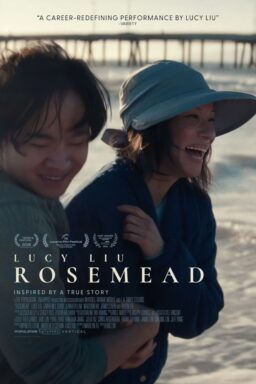TELLURIDE, Colo.–At some point early in his life, Michael Moore must have found himself wearing a baseball cap, a windbreaker, and a shirt hanging outside his jeans, and decided he liked the look. That’s what he was wearing when I met him at the Telluride Film Festival in 1989, and that’s what he was wearing here Saturday. It is also what he wears in “Bowling for Columbine,” his new documentary film, when he goes calling on K-Mart executives and Charlton Heston, the spokesman for the National Rifle Association. He is not necessarily wearing the same shirt and jeans, you understand. His closet must look a lot like Archie’s and Jughead’s, with rows of identical uniforms. The clothes send a message: Here is a man of the people, working-class. He may be on television but he is not of television. In his films, he is a huge hulking presence at the edge of the screen, doggedly firing questions at people who desperately wish they were elsewhere. His face is usually in shadow because of the baseball cap.
“Bowling for Columbine,” which had its U.S. premiere here over the weekend, as funny and abrasive as his hit “Roger & Me,” and much more sorrowful, is about the American love affair with guns. And not just with guns, but with shooting: A higher percentage of Canadians than Americans own guns, we learn, but they hardly ever shoot anyone with them. Gunshot deaths in the United States are 10 to 20 times higher than in other developed nations.
For once Moore does not seem to have the answers to all the questions he asks, and there is a certain humility at moments in this film.
He talks to gun owners who say they feel safer with guns in the house, and then he meditates on whether media coverage of violence may be making them feel threatened. One of his many eye-opening statistics is that in recent years violent death has been down 20 percent, but coverage of it on TV has been up 600 percent.
In the most astonishing sequence in the film, he takes two survivors of the Columbine massacre on a trip to K-Mart corporate headquarters. Both teens still have bullets in their bodies that were purchased at K-Mart, and in a Moore brainstorm they want to see if they can return them for a refund. One of the boys actually shows a K-Mart spokesperson the bullet scars on his back. K-Mart sends the usual series of P.R.-types to deal with Moore’s delegation, and we’re reminded of the General Motors spokesmen in “Roger & Me.”
But then a totally unexpected thing happens. K-Mart tells Moore and the boys it will stop selling ammunition in its stores. Moore is stunned: No one has ever agreed with one of his demands before. He has the K-Mart spokesperson repeat her promise. It’s true. K-Mart won’t sell bullets.
That may help a little, but comedian Chris Rock may be on to something in the film when he observes how cheap bullets are (the Columbine bullets were 17 cents apiece). Why not price them at $5,000, he suggests:
“And then you wouldn’t have any innocent bystanders.”
I’ll review the movie at length when it opens, including Moore’s interview with Charlton Heston and the way he links Michigan’s “work for welfare” laws to the death of a 6-year-old. After the Telluride screening, Ian Waldron-Mantgani, a teenage film critic from Liverpool, England, was shaking, literally shaking, as he left the theater. He was not alone.
*****
At most film festivals, movie professionals attend only to do business. At Telluride, they come for pleasure even when they don’t have a film to flog. Two of the recent guest programmers at Telluride have been novelist Salman Rushdie and British stage director Peter Sellars. Both are back this year, on their own, for fun. “Last year I spent all my time watching the films I programmed,” Rushdie told me. “This year I can go to films I haven’t seen.” Also here on busman’s holidays: the great Werner Herzog, the French master Bertrand Tavernier (who has a film, but comes even when he doesn’t), the documentarian Ken Burns, and the Czech-American filmmaker Ivan Passer. All hanging around, catching screenings, debating movies on street corners.
*****
The most astonishing technical feat at this year’s festival is without doubt the cinematography in “Russian Ark,” the new film by Alexander Sokurov of Russia. The movie is 96 minutes long, and was filmed in one single take by German cameraman Tilman Buettner, using a Steadicam mounting and a new Sony HD digital camera.
To describe the film as a journey through the Hermitage Museum in St. Petersburg would be missing the point. Using the great museum as his location, Sokurov follows a “time traveler” as he wanders through 300 years of Russian history. The camera movements are meticulous as the traveler encounters one group of actors after another, eavesdrops on conversations, examines paintings, witnesses a period of Soviet history when the museum was shuttered, and then waltzes into an astonishing gala ball with 2,000 costumed extras dancing in a vast ballroom.
*****
“Spider” the new film by David Cronenberg, is a bleak, moving meditation on the adult life of a man who was destroyed by his childhood and is still haunted by it. Ralph Fiennes stars in the story, based on a novel by Patrick McGrath. The time-line moves between his present existence in a halfway house for mental patients, and his childhood, when his brutal father (Gabriel Byrne) murdered his mother and moved in a floozy from the pub (both women are played by Miranda Richardson). The subject of the film is really the sadness and confusion in the mind of Clegg, the hero, whose tragic childhood seems destined to rerun in his mind until he dies.











